Caraway Rye Bread.
This is a favourite with my wife, and one I want to truly perfect in the next few months, for "Competition Bread" purposes. It works as follows: 75% Strong White flour, and 25% Dark Rye in the form of a 15 hour sourdough culture. Black strap molasses and caraway seeds for flavour; overall, just shy of 65% hydration.
Formulae, method and photographs shown below:
Rye Sourdough Refreshment and Final Dough for 2 large "Miche-style" loaves
|
Materials, etc. |
Formula [% of flour] |
Recipes in Grams |
|
1.First Refreshment: 11.02.2010. 20:30 |
|
Ferment, ambient for 24 hours [approx 18 - 20°C] |
|
Leaven from stock [wheat: 100 flour, 60 water] |
Flour: 7 Water:4.4 |
50 Flour31, water19 |
|
Dark Rye |
23 |
100 |
|
Water |
34.8 |
150 |
|
TOTAL@ 31°C |
69.2 |
300g |
|
2.Second Refreshment: 12.02.2010. 20:30 |
|
Ferment, ambient for 15 hours [approx 22°C] |
|
Leaven from above |
69.2 |
300 |
|
Dark Rye |
70 |
300 |
|
Water |
116 |
500 |
|
TOTAL @ 31°C |
255.2 |
1100 |
|
|
[Flour 100, Water 155.2] |
[Flour 431, Water 669] |
|
3.Final Dough: 13.02.2010. start mixing 11:30, finish 12:20 |
|
|
|
Rye Sour [from above] |
64 [flour 25, water 39] |
855 [flour 333, water 522] |
|
Strong White Flour |
75 |
1000 |
|
Salt |
1.8 |
24 |
|
Caraway Seeds |
1.8 |
24 |
|
Black Strap Molasses |
8 |
107 |
|
Water @ 40°C |
25.8 |
344 |
|
TOTAL |
176.4 |
2354 |
|
Notes: |
Pre-fermented flour [all rye] 25% |
|
|
|
Overall hydration 64.8% |
|
Method:
- Follow the refreshment timetable to create an active culture
- My kitchen was cool this morning [13°C], and flour and sour very similar [sour actually 18] Addition of cold syrupy molasses, so the water I used was bath temperature; even then the final dough was only 21°C. This is fine, although I would have liked 25; end result 2 hour bulk instead of 1½ hours. Anyway, you end up with a very sticky mass, so here is how to combine materials relatively pain-free. Weigh the hot water, and dissolve the molasses into this. Add this to the sour, and add the salt and caraway seeds. Mix together til blended. Add the white flour and loosely mix. Autolyse 30 minutes. Mix on the bench top, and between the hands in front of you [Andrew Whitley's "Air Kneading"; Breadmatters, 2006]. The Rye and Molasses make it sticky, but the strong flour means it will mix into a strong and developed dough, so persevere. Do not add any flour; that goes without saying, of course!
- Brush the bowl sparingly with olive oil, and store the dough, covered with plastic sheet for bulk proof in a warm environment. I do this on the hearth, just below and in front of our trusty wood-burning stove.
- Stretch and fold twice, after 40 minute intervals; see photos.
- After 2 hours bulk proof, scale and divide and mould. Set to final proof in bannetons, in similar conditions to bulk time.
- Pre-heat the oven for up to 2 hours to store heat in the bricks. Add boiling water to the roasting pan of hot stones at the oven base, to create steam. Tip the first dough piece onto a pre-heated tray, cut diamond-shapes across the whole crust surface, and place on top of the hot bricks to bake.
- Turn down the heat on the oven to 200°C after 15 minutes, and slide the dough directly onto the bricks. Use the hot tray to cover the roasting dish and thus prevent further steam formation in the oven chamber. I baked the first loaf [1290g weight] for 45 minutes, and the second loaf took 35 minutes [just over 1050g]
- Cool on wires.
Photographs , in sequence, are attached below, but no video, as these were made at home.
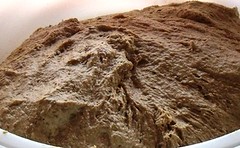
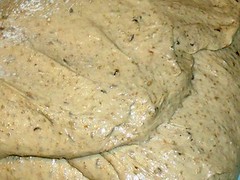

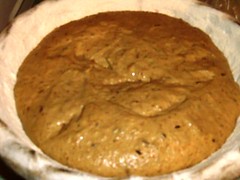
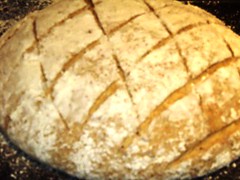



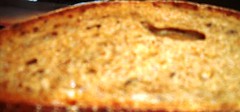
I also made some Ciabatta with "00" flour, a wheat levain and super-hydration of 85%. More details to follow; apologies for not quite capturing the full quality of this finished bread. It is quite superb in terms of flavour.
Best wishes
Andy
- ananda's Blog
- Log in to post comments
Hi Andy
Just by reading the very detailed and clear formulae for various rye sour builds and the final dough, and your method for the final dough, I already felt a great bread coming. Your pictures proved it. Thank you very much for sharing your recipe. I would love to give it a try.
A couple of small queries: You said your final dough was 21°C when mixing/kneading was complete. What was your estimate of the final dough temperature just before baking? Or, asked another way, what was roughly the bulk and proofing temperatures of the dough on the hearth in front of your stove, 28 - 30 °C? Was the stove on? (In one other post, you mentioned 30°C with the stove on.)
Secondly, you baked your dough on the pre-heated tray, instead of directly on the bricks, for the first 15 minutes of the baking time. Was this because the pre-heated tray was higher temperature?
Thank you.
Shiao-Ping
Hi Shiao-Ping,
Good to hear from you.
I didn't take a final dough temperature before baking, but I did take one at second S&F, which was 23*C. A good estimate would be 25*C. Our kitchen was down at 13*C this morning. We have a cat, so the house is basically open-plan, by default. So while our stove blasts out the heat, it is not enough for my doughs to get too warm.
Regarding setting the bread; I have 3 bricks on the shelf in my oven, with a baking sheet set on top. I pre-heat the sheet and then set the bread on to that and put this back on the bricks. Main reason is so the base of the bread is nice and smooth, and the dough doesn't drip into the cracks between the bricks! other reason is so I don't burn myself reaching into the oven to set the bread directly on the bricks. I move the bread directly onto the bricks after about 15 minutes, when it has sufficient structure to it. Life must be so much easier with a pizza stone and a Brisbane climate! Still in the depths of a cold winter over here!
Best wishes
Andy
Everybody's set-up is different.
The Winter Olympic is on. I watched the snow sports with much amusement. I am looking foward to March for cooler weather. To be fair, it hasn't been too bad for us; the Perth people seem to have a lot more hot weather than we've had this summer.
I really love black strap molasses with its bitterness and deep aromatic sweet sent. Your formula uses two of the best flavour enhancers that I like for bread. What a great idea to combine them with 25% rye (or 23.2% to be exact)! Thank you very much for the combination.
Best regards,
Shiao-Ping
Very attractive, Andy.
I't always a pleasure reading your explanations. May I ask if the purpose of the molasses is only to give color? I never used it, but I guess that the small amount you used isn't easily perceptible in the taste of the bread. Is it?
Hi Nico,
This is not a sweet dough, so I think 8% in the formul;a is about the correct level of sweetener to use. Yes, you can see the effect on colouration in my photographs.
As for taste and flavour, well I would say they are really quite pronounced. Molasses has a very powerful flavour, and I used a jar which is thick, and derived from organic and ethically-sound sources. It is quite intense, and it complements the sourness in the most perfect way. Please see what Shiao-Ping writes just above; she is spot-on. Also, we have a discusssion on-going, concerning my formula on her blog. This is the link: http://www.thefreshloaf.com/node/16213/mr-nippon039s-baguette-formulas#comment-104979
I have been forced to use black treacle in the past as a substitute; it is feeble in comparison.
Best wishes
Andy
I've been using black treacle in wholemeal bread for many years.
Black treacle is, I think, a refinement of molasses. You can buy it in the UK, perhaps not in the US. I used to call it my "secret ingredient", learnt from an aunt, which gives a rich nuttiness to the flavour of my bread. 2tbsp to 3lbs of flour.
Maybe I'll risk trying molasses instead, though I've tasted it and it's very bitter, while black treacle is sweet enough to use as a spread on toast.
Hi to both of you,
I think you have to look at the type of bread I have made here.
It's a rye sourdough, and it is quite easily capable of holding strong flavours such as caraway and blackstrap molasses. I would point you to the % I have added it in the formula: it's pretty low!
I take your points about its use as "a topical sweetener", and maybe it won't work in a standard wholemeal dough. Personally, there is a flavour in treacle which I'm not fond of. However, I have eaten wholemeal bread using treacle and found the flavour to be excellent. Isn't it about product knowledge, and being able to research and explore and discover which flavours work in which media?
Thank you for commenting, good to have you along
Best wishes
Andy
In Shiao-Ping's current blog entry: http://www.thefreshloaf.com/node/16213/mr-nippon039s-baguette-formulas#comment-104998 we were discussing the empirical hydration affect on the dough from using a sweetener such as molasses. For moisture content alone, I went back to the manufacturers, and received a swift reply stating moisture content in the molasses was between 20 and 28%. This is exactly as I would expect. However, Shiao-Ping was really more interested in how the use of the sweetener in the dough actually creates a much softer, stickier dough, which therefore has the appearance of a greater water level in that dough. I have been thinking about this, and discussed it just now with a lecturing colleague, to confirm I had the right ideas.
1. Sugar is hygroscopic; ie it takes up water. So, the potential remedy of cutting back on hydration to compensate can never work. Sugar will always beat protein in the competition for available water. This is why I dissolve my sugar into the water when making products such as scones and sweet pastes. This way, the sugar has already taken up the water it needs, meaning the rest is available to the flour. This allows easier and more effective hydration of the flour in the final stages of mixing, after the flour and fat have been crumbed together. I also dissolved the molasses in the dough water when mixing the caraway rye bread. Syrups are always difficult to deal with in processing doughs and confectionery mixes; I needed very warm water to make this dough, as the rye sour, flour and ambient room temperature were all cold, cold, cold [between 13 and 18°C!] So weighing the warm water and dissolving the molasses into it was the obvious way to start the mixing.
2.Sugar induces flow in a dough. It has a tenderising affect on the crumb, it enriches and provides pleasant eating qualities and textures, it softens the dough and it works as an Improver. It does this as follows: just like protease, or, l-Cysteine Dihydrochloride, or Sodium Metabisulphite the sugar starts to breakdown the protein structure in the dough. It has a softening effect on the gluten which the homebaker generally achieves through the wonderful [now, scanalously, somewhat old-fashioned in the UK commercial sector!] concept of fermentation. This enables the dough rheology which sees the strength of elasticity gradually replaced by the all-essential extensibility in a dough. Incidently, without sufficient hydration, the protein is incapable of being fully developed. This is why a tight dough always calls for extra mixing.
Best wishes Andy
... from elasticity to extensibility. That is very interesting, Andy.
Thank you for the explanation.
Shiao-Ping
Hi Andy
I started using black strap molasses in my wholemeal doughs mostly for the rich darkness that it imparts and although a slight hint of sweetness does come through in the eating it is never going to need a lower temperature during baking as it might if a purer sugar was added. i used it beacause it was there, and having tried it now often include it in multigrain breads. I also think a little goes a long way.
my other favourite darkening agent is dark stout of which i am rather partial to myself.
i recieved a brew kit for christmas and my second brew is a dark stout for BREAD MAKING puropses, it should be ready in a couple of weeks so watch this space.
regards Yozza
Hi Yozza,
You need a strong flavoured beer to get anywhere if using it as the liquor element in your bread: do you make your stout sweet [in UK we call it Milk Stout], or dry like Guinness?
Here's a trick for you. When you fine off the clear beer, use the sedimented yeasts to make a culture for your breadmaking. It's the same strain: saacharomyces cerevisiae! Or take a portion of your finished stout and mix it to a stiff paste with some flour...eh voila you have a barm [see Whitley A. Breadmatters (2006, pp25-8), also Peter Reinhart uses a barm in Bread Bakers' Apprentice, but I do not have that to hand; the way all bread was leavened in England for many centuries I suggest
Best wishes
Andy
Hi Andy the stout is good and strong very much like guiness, a couple of weeks and i will be using it, i have found coopers stout from south australia to be wonderfull in bread, it is coopers that make the brew kits and also sell the ingrediant packs.
I will have to try using the sediment in a batch of bread, probably take it to the college and put through a batch there.
I think i will take in a sample today to see how quick it revives.
regards Yozza
The beer in Oz was shocking when I was there 10 years ago...except for Coopers. A real ale in a bottle, in a beer dessert. Oh, I wish you well with both a sediment culture, and a barm.
Do you lecture in college?
Andy
Hi Andy i did my apprenticeship and worked as abaker for 10 years, gave it away when the bakery i was working at as the dough maker was being closed and moved to the other side of town.(multinational)
I then drove buses from a local depot for 21 years and the government decided to outsource the labour part so i decided to stay within government as an employee and ended up at tertiary teaching institution. I am employed as a supply and purchasing officer. The college has a hospitality training section for cooks and chefs and a training restaurant. We also have electrical and construction trades on our site. We have a number of sites that cover all manner of skills and trades
aquaculture, oil and gas, maritime , forensic science , hairdressing ,nursing,plumbing ,automotive the list goes on,
Purchasing for all these areas is very interesting as you can imagine.
As far as lecturing goes I do get invited into the bakery and assist some of the chefs with bread and roll production. we also have a great scheme where we have students from high schools that are showing an interest in certain trade areas that have a day at college a day on the job in the area of their interest . I do go into their class and show them scratch dough making, and hand dough making and hand skills,it really is like riding a bike. The program Student Aprenticeship Link SAL works well and you see quite a few of these students enrolled later doing their chosen trade.
I was even able to get the SAL kids from construction to build a wood fired oven for the Hospitality area, which has been great as i have always wanted one.
At Easter i get to spend the whole day with the students making Hot Cross Buns Just like the old days.
tell us about your Australian visit.
you have commented on the beer what about the flours and bread
REGARDS YOZZA
Hi Yozza, and thanks for posting above.
I spent 5 weeks travelling up the East Coast of Australia with a girlfriend at the time. This was 11 years ago now. We travelled from Melbourne to Cairns and back. It was a pretty mainstream trip at the time; I would do things differently if I got chance to go back. My partner had family in and around New South Wales, so we got to stay with them.
It was a good time to be travelling, as it was prior to introduction of GST, and The £ was very strong. Food and wine were great. I loved Melbourne; it was just at the time the artisan bread movement was about to kick off in the south of the city. But it was infancy only; I remember some great fashion shops just started.
Mainstream, a long-time friend of mine who originally hails from Melbourne, once described the bread as "woeful". He actually had his own artisan bakery, and gave it up to travel. We worked together in the mid and late 90s at Village Bakery, over in Cumbria; great guy, now runs "Panary" in Dorset, see link: http://www.panary.co.uk
Anyway, woeful is about right...I'm thinking the artisan stuff will be rather good these days?
All good wishes
Andy
I tend to remember the extremes. I have a gingerbread cookie recipe that asks for no liquids other than that of eggs and honey in rye flour, sugar is also added. Upon mixing the dough it is so stiff, that forming a cohesive mass becomes a chore. The dough is then rested for days or weeks at a cool temperture. The dough then becomes supple and manageable. The more it sits (within reason) the better the dough. I might be inclined to call it a re-disribution of moisture but chemically...
I can imagine that molasses would have a similar affect, mildly deflocculating the dough with time rendering it "wetter."
Mini
Hi Mini,
Good to have you along, sorry for the delay in replying, I've been away a couple of days.
I made a lot of gingerbread recipes with students last term, including one very wet one from a Nigel Slater recipe. I love good gingerbread.
But I'm not that fond of rye flour in cakes, could be a contraversial comment here!!? Your recipe sounds really interesting, especially when you start to think how much moisture the rye flour would normally take up in those days/weeks of resting. Very revealing of the softening effect of sugar I agree.
I always like to use heat and introduce both flow and the added bonus of caramelisation for extra flavour, by melting the butter, dissolving the syrup into that, then heating it close on boiling. Still this gives the excuse to use your wonderful word "deflocculating". How excellent is that. Any chance you could share the recipe details?
Best wishes
Andy
Meanwhile... Caraway, your recipe, any special handling before throwing it into the dough? Roasting, chopping, grinding, crushing, soaking?
I'm not fond of rye in cake either, prefer spelt and 8% protein flours. Rye weighs down my fluffy egg whites.
Mini
Hi Mini,
Just add the caraway seeds whole to the dough, unless you have an alternative personal preference.
I'm sure you have a good reason; why May?
Best wishes
Andy
At your suggestion, I mixed my rye sour to about 110% hydration; and I did one hour autolyse of the final dough flour and water (I was going to experiment on a much longer autolyse, but forgot about it at the last minute).
I didn't get as open crumb as you did but my bread, judging from the pictures, seems to have more volume than yours. I can't be sure, and I don't know why. My strong bread flour has 13.2% gluten. I used the slap and folds for kneading. I don't think I over-worked the dough. There is a dark, flour folding mark about an inch below the crust. I don't know why it was there. I don't think I folded extra flour in when I shaped. It wouldn't be molasses, because it was dissolved in the water for use before autolyse.
The crumb structure I got is similar to that of most miches I made of similar hydrations.
I love this hearty combination of caraway seeds and molasses with 1/4 rye flour, good for winter and light enough for summer!
Thank you very much for a great formula.
Regards, Shiao-Ping
Hi Shiao-Ping,
From the outside, a very similar looking loaf, but, yes, there are those small differences you are quite right. I got to thinking about why. Maybe I have the answer, maybe not?
I don't come from the "slap and fold" school. I like "stretch and fold", but I also like to work the dough first; especially if the protein is 13.2%. This is not essential; just remember I generally had a spiral mixer sitting next to me that could fully develop dough like this in a way impossible to comprehend using side by side comparison with hand-mixing. Imagine, also, that the task in hand was to deposit 120kg of dough on the bench for 2 skilled bakers to work off by hand: slap and fold won't work; but it's fine at home, for 1 -2 kg, yes? But I think the use of both rye and wheat gives the game away here. The white streak in the dough looks like some wheat that has not been mixed with the rye sour properly. That is picture 3. For all that, picture 4 suggests a really lovely bread, and I love the crust expansion seen in the first 2 photos.
Some other things to bear in mind: my dark rye flour is very coarse, and dark. The molasses is pretty rich and heavy. Combine these 2 features, and my bread is heavier than yours. Then add in the more vigorous work input I use and I think that explains the difference in finished breads from a similar formula and method. In the end, flour at 13.2% gives the essential result, if properly hydrated, as the formula is. But slap and fold does not "mix" the dough how I want it to. Time and hydration do all the important things to create the highest quality of dough; exactly it: extensibility is the key!!!
The other thought I'm having as I close these remarks is very obvious: a tighter culture [stiffer] will ferment slower, and be less ripe. Therefore the acid content will be lower, so the dough structure will be stronger, and will break down slower: so you will indeed achieve a loaf of greater volume, yes?
Best wishes;
Andy
Now that you mentioned the stiffer levain that I used in relation to the volume that I got, it made sense to me now. Thank you.
I misunderstood your method in your post. I did not double check my book for "air kneading" - I thought you were referring to the slap and fold method; not to worry. I am very curious now - which spiral mixer do you use for home? San Francisco Baking Institute has one for home use that can mix 4 kg dough, which is supposed to be very good.
Shiao-Ping
Hi Shiao-Ping,
I don't have a spiral mixer at home. I was referring back to when I used to mix large quantities of dough for the likes of pains de campagne. We would mix anywhere between 120 and 180kg at a time. I used a variety of decent machines over the years. I have a small spiral mixer in my College Bakery kitchen. This would mix upto 8kg I think [dough, not flour]. It is single speed and single direction only, so it mixes very slowly. It takes around 15 minutes for the dough to develop properly. The bigger machines have 2 speeds and a setting to move the bowl either direction. A large quantity of dough will mix in 8 -9 mins. Generally, the bigger the mix, the more development is possible, due to the amount of energy being imparted. The make of the small mixer is Moretti Fourni. I also bought 2 x 10quart upright mixers from the same company.
So when I mix at home, I put high work input into the dough, but generally always mix by hand. It is extremely difficult to overwork dough by hand, if using high protein flour. I have known it happen with softer flours. I actually worked this dough by hand on the bench. It was very sticky, so I had to have a few rests along the way, and employ the use of a trusty plastic scraper, and a wee dash of olive oil to the hands.
When it comes to super wet ciabatta, I tend to make small amounts and mix it with my electric cake mixer, only with the hooks, not the whisk blades. So long as the dough is made with cold water, it's fine. "Air kneading" is fine for this: think about moving the dough between your hands directly in front of your stomach, in a motion reminiscent of playing an accordian! But it takes a long time; you soon develop very good shoulders with this technique.
Best wishes
Andy